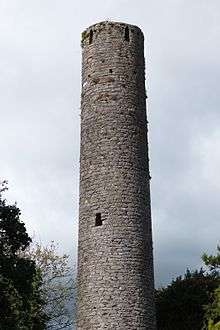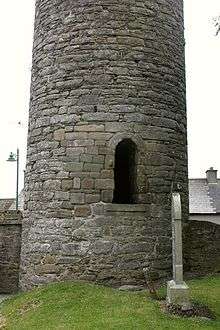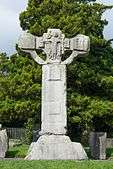Kells Round Tower
| Kells Round Tower | |||||||||
|---|---|---|---|---|---|---|---|---|---|
| Cloigtheach Cheanannais | |||||||||
 Round tower at Kells | |||||||||
 Shown within Ireland | |||||||||
| Basic information | |||||||||
| Location |
Farrell Street, Kells, County Meath, Ireland | ||||||||
| Geographic coordinates | 53°43′38″N 6°52′49″W / 53.727302°N 6.880161°WCoordinates: 53°43′38″N 6°52′49″W / 53.727302°N 6.880161°W | ||||||||
| Affiliation | Pre-Reformation Catholic | ||||||||
| Heritage designation |
| ||||||||
| Architectural style | Irish round tower | ||||||||
| Groundbreaking | 10th century | ||||||||
| Height (max) | 26 m (85 ft) | ||||||||
| Materials | sandstone, limestone | ||||||||
Kells Round Tower is a round tower in Kells, County Meath in Ireland. The tower, and the high crosses nearby, are National Monuments.
History
Kells was founded as a monastic settlement by Saint Columba c. 550 on land that had been gifted to him by the King of Tara - Diarmait mac Cerbaill. Columba was exiled after the Battle of Cúl Dreimhne (AD 561). The Abbey of Kells was refounded in the early 9th century by monks from Iona. The high crosses were erected in the 9th/10th century and the round tower in the 10th century.[1]
The Annals of Tigernach state that in 1076 "Murchadh son of Flann Ó Maolseachlainn, was treacherously killed by Olaf son of Maelán, king of the Galenga, in the round tower of Kells, and straightway, through a miracle of St Columcill's, Olaf himself was killed by Maolseachlainn son of Conchobhar." Olaf (note the Norse name) was king of Gailenga Brega, a kingdom located between the River Liffey and Santry. Murchadh was King of Mide for a time in 1073. Maolseachlainn son of Conchobhar was himself later King of Mide, 1094–1105.
Like most round towers, it has lost its cap, possibly due to lightning strikes.
Tower

The tower stands 26 m (85 ft) high. The doorway originally stood about 3.6 m (12 ft) above ground level and was reached by wooden steps or a ladder. Most round towers have four windows on the top level, one for each cardinal direction, but Kells has five, supposedly one facing each road into the town and each town gate.[2]:4
The crosses
There are five high crosses:
- Cross of St Patrick and St Columba (South Cross): the earliest cross, erected in the 9th century. Carved scenes include Adam and Eve, Cain and Abel, the Three Children in the Furnace and Daniel in the lions' den.
- West Cross (Ruined Cross): Adam and Eve, entry into the Promised Land, Marriage at Cana, Baptism of Jesus and his triumphal entry into Jerusalem. Supposedly the cross was damaged by soldiers of Oliver Cromwell.
- East Cross (Unfinished Cross): incomplete; it gives an insight into how crosses were carved, with the details being added on site.
- Market Cross: 3.35 m (11.0 ft): as well as religious scenes (including David with lyre, the Binding of Isaac and the temptation of Saint Anthony) there is depicted a deer hunt, birds, animals and centaurs.
- North Cross: only the base remains.
| High crosses | ||||||||
|---|---|---|---|---|---|---|---|---|
|
References
- ↑ http://www.visitingkells.ie/roundtower/
- ↑ Kells & District (PDF). Kells & District Tourism Forum.
